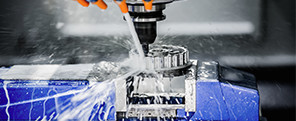Goodbye, Tramp Oil
Tramp Oil Contamination Is Not Inevitable
By: Mark Copeland, Key Account Manager, Acculube
Tramp oil can shorten the life of your coolant, sicken your employees, compromise machine performance, cost you money, and leave a residue of destruction. Yet, some industrial manufacturing companies and machinists think that tolerating it is the cost of doing business. IT'S NOT.
Tramp oil is a non-soluble contaminant. This unwanted oil can enter your metalworking fluid from a variety of sources, including leakage of way, gear, spindle or hydraulic oils. It can also come in on oil or corrosion preventative on parts from previous operations. Like most contaminants, it must be removed.
Production Machining magazine said this about tramp oil in March 2014: "By using the right tramp oil purification process and equipment, metalworking operations can see a 40 to 80 percent reduction in coolant purchases and a corresponding decrease in disposal costs."
What’s the Problem with Tramp Oil?
All metalworking fluids, including coolants, are susceptible to biological issues like bacteria and fungi. Tramp oil in particular is a limitless buffet for bacteria. As it eats, the bacteria colony grows – it can double every 30 minutes - and so does its odor. It can become so unpleasant that it's nearly impossible for the machinist to operate the machine. It is not uncommon for it to cause respiratory and dermatitis issues.
But odor isn't the worse of it. Bacteria also causes foaming, splits the emulsion (thus compromising its detergency) and lowers the pH of the coolant, diminishing critical properties such as lubricity. Lubricity is the coolant's ability to aid in the cutting process by keeping the tool clean and cool, reducing friction, and removing fines. Without effective lubricity, machine tools wear down and require more repair.
Corrosive salts and acids, including hydrogen sulfide, that are released by bacteria in the tramp oil will also attack seals and paint finishes. And tramp oil can affect the tolerances and surface finishes of your finished product as well; because bacteria darkens the metalworking fluid, stained parts are commonplace when tramp oil is not well controlled.
Did I mention the sticky residue tramp oil leaves on machine tool parts? That is an issue as well.
Banish Tramp Oil in 3 Easy Steps
A minor amount of tramp oil contamination is inevitable in every shop. But the more you can contain and remove it, the more you'll extend the life of your machines and minimize coolant costs. Clean coolant only needs to be changed about annually. Unclean coolant, rampant with tramp oil, is typically changed about every three months. Coolant changes often involve two to three hours of downtime, and there are labor and other costs involved as well.
- Repair the Leak
Leaking oil systems in a machine make tramp oil contamination exponentially worse. If possible, find the leak and fix it. This is especially true of older machines that tend to leak more.
- Choose the Best Coolant for Your Machine
Some coolants reject tramp oil better than others. An oil rejection additive in the coolant acts as an oil/water separator, separating the tramp oil from the coolant and floating it to the top. Talk with your lubricant supplier about this important aspect.
- Remove the Tramp Oil with an Oil Skimmer or Baffle
Once floated to the top, the tramp oil needs to be removed. The simplest option is an oil skimmer. An oil skimmer is a 2-inch-wide or wider belt that is immersed in the tank. The tramp oil sticks to the belt, and when the belt is removed, blades wipe the tramp oil from the belt before its return trip to the tank. For an oil skimmer to work properly, the tank has to be still.
Many companies run the oil skimmer on an off shift. If the machine runs during first shift only, the tramp oil is skimmed during second shift. Sometimes, however, production demands require that a machine run constantly, preventing the tank from ever being still.
When you can't skim the tramp oil directly from the machine, you have to remove it using an overflow tank and baffles. The coolant is removed, a portion at a time, and placed in a holding tank where it flows over a series of baffles to separate the tramp oil. Baffles are made of metal and look almost like a fan blade. As the coolant flows through them, they attract the oil. Baffles remove tramp oil faster than a belt oil skimmer.
The Centrifuge Controversy
Centrifuges are a newer tramp oil removal technique that has spawned controversy due to confusion on how best to use them. Self-cleaning centrifuges are designed for central fluid systems. They pull the fluid, remove oils and small fines, and return cleaned fluid to the central system.
Most coolants, including semi-synthetics, contain both good oil and bad (tramp) oil. Centrifuges can't tell the difference, an unfortunate limitation that can raise coolant costs.
Tramp oil is not inevitable for machine shops. Using the correct coolant and establishing a system for removing tramp oil can not only improve worker safety, but save money on coolant replenishment, machine tool repair and end product rejects.
ABOUT THE AUTHOR: Mark Copeland is Key Account Manager for Acculube, a Dayton-Ohio based supplier of metalworking and manufacturing fluids to American manufacturers, machine shops and vehicle fleets.
NEXT ESSAY
 |
|
Get the best lubrication – and great advice maintaining your industrial machines and vehicles. Email Acculube or call us at 1.800.404.2570.
|
|


